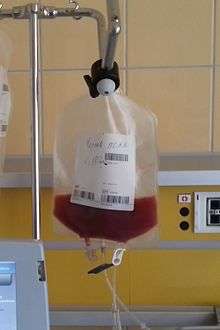Peripheral stem cell transplantation

Peripheral blood stem cell transplantation (PBSCT), also called peripheral stem cell support,[1] is a method of replacing blood-forming stem cells destroyed, for example, by cancer treatment. PBSCT is now a much more common procedure than its bone marrow harvest equivalent, this is in-part due to the ease and less invasive nature of the procedure.[2][3] Studies suggest that PBSCT has a better outcomes in terms of the number of hematopoietic stem cell (CD34+ cells) yield.[4]
Immature blood cells hematopoietic stem cells in the circulating blood that are similar to those in the bone marrow are collected by apheresis from a potential donor (PBSC collection). The product is then administered intravenously to the patient after treatment. The administered hematopoietic stem cells then migrate to the recipient's bone marrow, a process known as stem cell homing, where the transplanted cells override the previous bone marrow. This allows the bone marrow to recover, proliferate and continue producing healthy blood cells.
The transplantation may be autologous (an individual's own blood cells saved earlier), allogeneic (blood cells donated by someone else with matching HLA), or syngeneic (blood cells donated by an identical twin). The apheresis procedure typically lasts for 4–6 hours, depending on the donors total blood volume.[5]
Preparation prior to PBSC Collection
GCSF
Granulocyte colony stimulating factor (GCSF) are naturally occurring glycoproteins that stimulate white blood cell proliferation. Filgrastim is a synthetic form of GCSF produced in E.coli.[6] PBSC donors are given a course of GCSF prior to PBSC collection, this ensures a better outcome, as stem cell proliferation increases, thus increasing the number of peripheral stem cells in circulation. The course is usually given over a 4-day period prior to PBSC collection.[7] Mild bone pain usually results due to the excessive stem cell crowding within the bone marrow.
Complications
Since allogeneic PBSCT involves transformation of blood between different individuals, this naturally carries more complications than autologous PBSCT.[8] For example, calculations must be made to ensure consistency in the amount of total blood volume between the donor and recipient. If the total blood volume of the donor is less than that of the recipient (such as when a child is donating to an adult), multiple PBSCT sessions may be required for adequate collection. Performing such a collection in a single setting could result in risks such as hypovolemia, which could lead to cardiac arrest, thus health care providers must exercise careful precaution when considering donor-recipient matching in allogeneic PBSCT[9]
References
- ↑ "Dictionary of Cancer Terms". Retrieved 2 March 2012.
- ↑ "Stem Cell Transplant (Peripheral Blood, Bone Marrow, and Cord Blood Transplants)". Retrieved 4 March 2012.
- ↑ "Peripheral Blood Stem Cell Harvest". Retrieved 4 March 2012.
- ↑ Singhal, S; Powles, R; Kulkarni, S; Treleaven, J; Sirohi, B; Millar, B; Shepherd, V; Saso, R; Rowland, A; Long, S; Cabral, S; Horton, C; Mehta, J (March 2000). "Comparison of marrow and blood cell yields from the same donors in a double-blind, randomized study of allogeneic marrow vs blood stem cell transplantation.". Bone marrow transplantation. 25 (5): 501–5. doi:10.1038/sj.bmt.1702173. PMID 10713626.
- ↑ "Bone Marrow Transplantation and Peripheral Blood Stem Cell Transplantation".
- ↑ Welte, K; Gabrilove, J; Bronchud, MH; Platzer, E; Morstyn, G (Sep 15, 1996). "Filgrastim (r-metHuG-CSF): the first 10 years.". Blood. 88 (6): 1907–29. PMID 8822908.
- ↑ "G-CSF Administration".
- ↑ Cutler, C; Antin, JH (2001). "Peripheral blood stem cells for allogeneic transplantation: a review.". Stem cells (Dayton, Ohio). 19 (2): 108–17. doi:10.1634/stemcells.19-2-108. PMID 11239165.
- ↑ Sevilla, J; Plaza, SF; González-Vicent, M; Lassaletta, A; Ramírez, M; Madero, L; Díaz, MA (2007). "PBSC collection in extremely low weight infants: a single-center experience.". Cytotherapy. 9 (4): 356–61. doi:10.1080/14653240701320270. PMID 17573611.
External links
- Peripheral stem cell transplantation entry in the public domain NCI Dictionary of Cancer Terms
![]() This article incorporates public domain material from the U.S. National Cancer Institute document "Dictionary of Cancer Terms".
This article incorporates public domain material from the U.S. National Cancer Institute document "Dictionary of Cancer Terms".